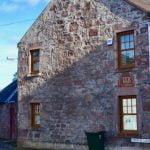The Picts were a group of tribes who lived in Scotland, north of the Forth, until the late 800s. They began to convert to Christianity from as early as the 5th century.
Twenty six pieces make up the collection, including cross slabs, recumbent gravestones, a hogback stone and rare architectural fragments. Their defining characteristic is their powerful imagery of animals and hybrid monsters, often with a violent tone and a sense of imminent threat and damnation.
All the stones are sandstone, which is relatively soft and an excellent medium for detailed relief carving, though equally vulnerable to weathering.
One of the most majestic of the stones, the cross-slab known as Meigle 2 dominates the collection. It stands 2.5m high and probably stood by the churchyard entrance.
Meigle 2 is said to have marked the grave of Vanora, the Scottish name for Guinevere, wife of King Arthur. And indeed the stone, along with others was previously situated on a prehistoric burial mound, said to be hers, which lies in the churchyard next to the schoolhouse.
Folklore has it that whilst Arthur was on a pilgrimage to Rome, she was abducted by his nephew Mordred, whom he had appointed to act as regent and rule in his place. The story says Mordred held her captive on at the Pictish fort of Barry Hill, near Alyth, but Arthur found out, he returned and sentenced her to be torn apart by wild beasts – believing her to have been unfaithful.
The scene on the back of Meigle 2, which the Christianised interpretation describes as Daniel in the Lions’ den, was believed to depict this grisly event.
This story, along with other elements, including the now demolished Arthurstone, said to have stood three miles south east of Meigle, have led some historians to suggest that Meigle was an Arthurian cult centre in the late medieval period.
The documentary references to Meigle are now accepted as pointing to a secular and ecclesiastical power centre and place of aristocratic, possibly royal burials.
The architectural fragments that form part of this collection suggest the church was a complex building and on the basis of the size, nature and quality of the sculpture collection, and the size of the sub-circular enclosure around the present church, it can be assumed that there was an important early Christian foundation at Meigle.




